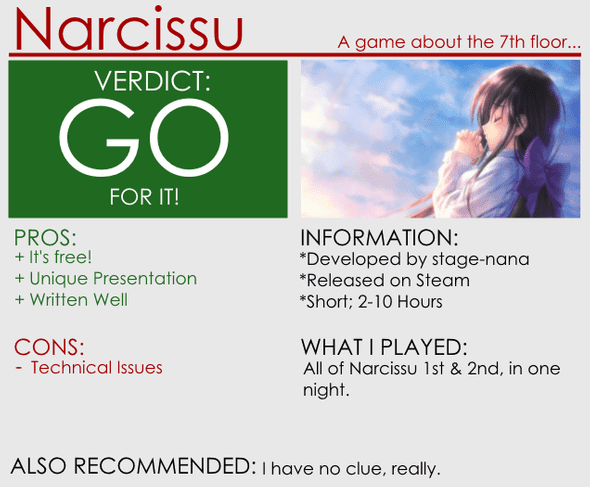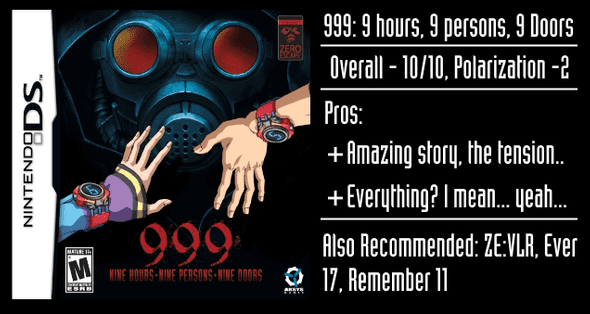
If you’ve read any of my reviews and wanted to know why I did them the way I do,
here’s an explaination of them, for those who came here from said review, or someone around TAY that sees them every
now and then. Since my review system deviates a bit from the TAY
and Ani-TAY review systems that it’s surrounded by, and
it has a few quirks , I figured it wouldn’t hurt to give this a bit of explaining on my review system.
Categories
Every now and then, I’ll use the TAY/AniTAY review’s Fantastic, Not Great, and
Terrible, but I usually have different categories sorted by the topic instead of the quality. In the respective order,
the categories for review I personally use is Writing, Visuals, Sound, Gameplay, Source Material Comparison,
Experience, and Conclusion, but usually the Order changes depending on importance.
Also, I now have a checklist
of everything I look for in a work in a checklist to help make sure I mention everything I want to say.
- Writing - This category focuses on the story, execution of plot, themes, tone, quality of writing
in general, pacing, characters, etc. Pretty much anything that involves the writing of it. I typically have the
sub-categories of Plot, Pacing, and Characters, and sometimes they get their own dedicated categories right after
writing depending on how varied the quality of the sub-categories are, or the level of importance.
- Gameplay - For games, this is about the interactions you have. It’s usually about the quality of
control, unique gameplay aspects, and experiences of actually playing through it. Sometimes, pacing can fall in here
due to the fact that gameplay can effect the pacing of the story. This segment does not appear in games that do
nothing special (or worth mentioning) or anime.
- Visuals - Rates how nice (or not so nice) something looks. Pretty self explanatory.
- Sound - Rates the quality of the Soundtrack, how well it used it and Voice Acting if said work
had some. The Soundtrack itself is only half of the equation; the usage of the soundtrack to make the mood of the
show is equally as important, and Voice Acting can really influence your thoughts on characters.
- Source Material Comparison - This category is almost never called this, it’s usually called the
media of the source material. In this, I don’t rate it, i just compare the 2 and say which one I prefer. This only
pops up when I have seen the source material, and if the topic of the review actually has a source material, so it’s
not that common.
- Experience - This is, in my opinion, the most important section. This is my personal thoughts on
it, what I experienced during this, my enjoyment of it, etc. What’s the point of a review if you can’t get your
thoughts out, saying that something is good if you don’t care for it? Every review has an aspect of subjectivity,
this is where a majority of the subjectivity in my reviews lie.
Banners
This one is a pretty recent change, but I’m a fan of how it looks so i’ll keep on
doing it. I’ve started to change the colors on the banners for the categories (or have entirely different banners)
depending on the said work. It’s just an aesthetic change and doesn’t influence the review’s actual contents. Here’s
an example from my Rewrite review, FSN UBW review and Sound of Drop review to represent the different types of banners I
use.



Scores
I use a 1-10 scale to rank the quality of the work in my reviews, with 7 as average,
just like the letter system for school. I’m familiar with it, and it’s easiest to place it for me. Everything is
compared to stuff I’ve already reviewed to, so the higher number means better in my eyes. Keep in mind this is ranking
quality, not how much I enjoyed it.
I’ll break the number system down a bit more to help clarify this.
- 1-4: Does nothing right. You’ll never see something like this. The variation in number is how
much I hate it.
- 4-6: Screws up something so badly that it’s no longer enjoyable, but does have 1 or 2 categories
that weren’t horrible. Think of something like Mekakucity Actors.
- 6-7: Sub-Par shows. Something that should have been good, but due to major flaws, they weren’t.
Usually they are pretty good in most fronts, but one or 2 parts just tank horribly. Some people might like them, but
they weren’t good in my eyes. The biggest difference between a 6 and a 7 is personal enjoyment. Think of stuff like
Aldenoah.Zero or Valvrave.
- 7-8: Average. Doesn’t stand out, but isn’t horrible either. They may have some flaws, but they
are pretty good in general. I like to think of SAO Season 1 or I/O.
- 8-9: Good. Stuff that I thought were good, but not necessarily amazing. These can also be stuff I
thought was amazing but with a massive flaw. I like to think of Rewrite, or Remember 11.
- 9-10: Amazing. Stuff you should experience, stuff that blew my mind. These are great works that
you should check out. They have minor flaws, but I enjoyed them too much that they are a non-issue. Stuff like
Steins;Gate, and G-Senjou no Maou come to mind.
- 10: Out of this world. The best of the best.
Polarization
Polarization is usually my thoughts on what you might think of it, or others do. The
larger the number, the more polarizing.
To give an example, I rather disliked Mekakucity Actors. I gave it a 5. Some people find it average, so
the positive polarization is +2.5. There’s also the chance that some people might like it even less than I did, (I
almost gave it a 4) so the negative polarization is -1.
Tiers
These tiers are my personal thoughts on said work, and if you asked me what I thought
about them, they would fall into said category. These ranks how much I enjoyed them. Keep in mind that quality,
personal thoughts, and recommendations are all different, so in my reviews, I split them up.
The tiers are:
- Rockmandash Regrets - If you see this tier, I don’t like it and I wouldn’t recommend it. Stay far
away.
- Rockmandash Regular - I thought they were average. I enjoyed them, but I didn’t really care too
much about them.
- Rockmandash Recommends - This tier is kinda self explanatory, these are shows and games i’d
recommend, because I enjoyed them and they were pretty good overall. They have flaws, but they don’t prevent it from
being enjoyable.
- Rockmandash Remarkable - which are Shows and Games that i’d recommend to everybody because they
are really amazing works, and I really loved them. This is stuff that would be on a Top 10 list, in my eyes.
Recommendations
For my thoughts on if you should check it out I just rely on the TAY’s Verdict
system. These do not correlate with my personal thoughts on the show and can differ.
- GO for it! - Stuff I’d recommend
- Proceed with caution. - Stuff i’d recommend depending on who you are.
- Not worth your time. - Stuff you should stay away from.
Ending
Card
I used the same title card as everyone else originally, but when TAY originally
changed the review card to this style of ending card
that’s in place, I disliked some of the omissions in the new card info-wise so I decided to tweak it a bit and make it
my own. These tweaks eventually lead to the AniTAY Review card, so I use a variation of that (pros/cons instead of
Who’s it for and not for) or I use a custom card, depending on review. They are small changes, but I prefer it this
way.
Here are some examples of both types:


Policy on
Edits
My reviews will constantly change. If I go back to it and find that
something’s off about it, I’ll go in and tweak it. If there’s so much change that it’s so different that you can’t
tell it’s the same review, I’ll redo it under my Review+ name, or what i’ve been doing lately, which is making an
archive copy at the end of the post.
Policy in
regards to content in VNs
I will review any VN that I feel like is worth my time and
has a good enough story to warrant a review, but I have to cross my lines somewhere. I kinda have to review some 18+
VNs, because there are so many but I will never review a VN in which Fanservice, or H-scene are the main selling point
of the game, so you’ll never see me review a nukige. Also, gag VNs are out as well, just FYI to those devs who want me
to review your VNs.
That’s it for the explanation for how I categorize and
rate my reviews, if you were confused about it. This explanation will be at the bottom of every review, for your
convenience.
Note: This has been edited on 11/15/2015. To see what
the old version looked up, click this link here, it’ll
send you to a google docs archive of the old article.





